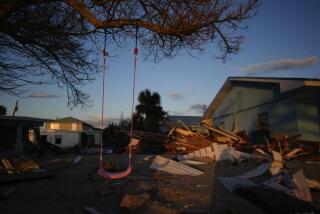Newspapers Improvise With Web Editions and Blogs
The New Orleans Times-Picayune did not publish today, offering only an Internet edition while struggling to find a location to print Louisiana’s largest newspaper.
One consolation for reporters and editors is that it’s not clear how many people would have a chance to read the 260,000-circulation paper.
“Things are so bad in the city that there are no ways to get copies of the paper to anyone anyway,” said Mark Schleifstein, the environmental reporter and hurricane expert drafted into duty as the paper’s spokesman in the crisis. “The water is continuing to rise and people are pouring out of the city.”
The 168-year-old newspaper continued to publish stories and photos on its website nola.comwhile its publisher and managers scrambled to find an alternative site to print its daily edition.
The crisis at the Times-Picayune exemplified the challenges facing the media throughout the region being lashed and flooded by Hurricane Katrina. The newspaper was among several news outlets that moved into temporary workspace outside the flood zone and struggled to communicate with reporters, who were bedeviled by spotty phone service.
The Times-Picayune’s challenges came to a head Tuesday morning. Many reporters and editors were already ragged from spending two nights in the newsroom. The air conditioning had gone out and a generator providing the only electricity was running low on gasoline.
As the floodwaters continued to rise after 11 a.m., Publisher Ashton Phelps Jr. gathered workers in the newspaper’s cafeteria and told them it was time to abandon the offices and regroup at a safer location.
By Tuesday afternoon, six delivery trucks that normally carry bundles of newspapers instead delivered Times-Picayune journalists to makeshift space at two other newspapers -- the Houma Courier and the Baton Rouge Advocate. From those remote locations, the paper continued to publish bulletins on its website.
It’s a measure of how bad things had become in New Orleans that the journalists were relieved just to be working again, even in the Houma paper’s cramped conference room. “We have phone lines and a wireless Internet connection and the whole bit. We are blessed to say the least,” Schleifstein said.
Other news operations also moved to safer ground and -- with some reporters scattered and trying to attend to their own family crises -- a few outlets relied on civilian Internet reporting to provide information on trouble spots, evacuation centers and other details.
With its transmitter down, NBC affiliate WDSU-TV Channel 6 moved its news anchors and other staffers to WAPT-TV Channel 16 in Jackson, Miss., a sister operation in the 28-station Hearst-Argyle Television chain. A reporting crew from the station remained behind and recorded images of, among other things, floodwaters forcing Oschner Hospital to move patients to upper floors.
The station broadcast its reports on the Web until 7 p.m., then relied on another Hearst station in Orlando, Fla., later in the evening.
“I have been in this business a long time and we have covered a lot of stories, but this must be the most difficult,” said Fred Young, a 40-year television veteran and senior vice president for news with Hearst-Argyle.
The New Orleans station’s operators said they didn’t know when they would resume normal broadcasts.
In the meantime, it could not be determined how many viewers in the area could see online broadcasts or read online accounts, given massive power outages.
News outlets provided a broad range of coverage.
The Times-Picayune’s Web reports -- initially under a red banner headline “CATASTROPHIC” -- included an update on efforts to close broken levees that protect New Orleans, a report estimating damage from the hurricane at up to $26 billion and a link to an earlier series, “Washing Away,” that explained the hurricane threat facing the city.
On Mississippi’s Gulf Coast, the Sun Herald newspaper was headlined “Not Since Camille,” in reference to the devastating 1969 hurricane. The paper quoted Biloxi Mayor A.J. Holloway saying: “This is our tsunami.”
The paper also set up a blog, eyesonkatrina.blogspot.com, that encouraged readers to report their experiences in the hurricane and established an “I’m OK Line” for readers to call so they could be listed among the survivors.
The technical reach and sizable staffs of the national cable television operations were much in evidence Tuesday.
CNBC provided a detailed analysis of the economic devastation from the hurricane, focusing on damage done to oil platforms in the Gulf of Mexico and refineries onshore.
Several CNN reports made the immense power of the storms evident -- particularly one showing an oil platform that had been anchored miles offshore beached on the coast at Dauphin Island.
“I just can’t fathom the kind of intensity and power that brought something like that to land,” said Bill Flowers, an airborne traffic reporter who shot the footage.
The hurricane also knocked WWOZ-FM (90.7), a longtime home of jazz and roots music, off the air. But e-mail continued flowing into the station’s message board from around the world.
One suggested that everyone who has “enjoyed the warmth and hospitality and general good feelings” of New Orleans contribute at least a dollar toward relief efforts.
Another left the city and its denizens with a blessing.
“May all Saints, Spirit Guides and Angels protect and continue to bless the richest culture in our country,” the message read. “God bless the people of New Orleans!”
More to Read
Sign up for Essential California
The most important California stories and recommendations in your inbox every morning.
You may occasionally receive promotional content from the Los Angeles Times.











